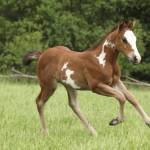Regular Exercise Important for Bone Development in Young Horses

Multiple factors are involved in the onset of developmental orthopedic disease (DOD) in young horses. Some are identifiable, while others are unknown. Genetic predisposition, conformation, unbalanced nutrition, and exercise patterns have been said to contribute to the etiology of DOD.
If a number of foals on one farm are affected, there may be a common factor that can be changed by management adjustments. When investigating a herd problem, the bone formation disturbances of each individual must be identified. The same herd-wide insult causes different clinical signs when different anatomic sites are involved, and effects vary in severity and signs when individuals of different ages are involved. It is only by identifying the commonalities of a herd situation that causes and eventually therapy can be identified.
An important stimulus for bone formation is the exercise which the newly formed bone is expected to withstand. A gradual increase in body size combined with gradually increased strength and activity causes the developing bone to be gradually trained to accept the load to be applied. Danger appears when this slowly increasing load, which results in incremental adaptation, is suddenly changed.
Stress, a product of body load and activity, dictates the size and number of mature bone cells produced to withstand the stress applied. Since growth occurs at such a rapid rate in the foal, continual stress is a necessity to dictate proper bone formation. Deprivation of exercise due to illness of the mare or foal or other influences such as weather or management practices can leave the foal’s newly formed bone inadequate when normal exercise is resumed. A few days of reduced exercise are generally of little consequence, but several weeks of confinement can result in a significant amount of structurally inferior bone.
When exercise is resumed, the now larger foal’s normal activity can change stress to trauma on the poorly prepared bone. The injury to the bone can disturb bone formation to the point that physitis and OCD can result. If a young horse’s exercise is curtailed for a prolonged period, it must be resumed gradually to circumvent the risk of disturbed bone formation. If the return to exercise is accompanied by signs of overload (most evident at the rapidly growing physes as inflammation and lameness) then the quantity of daily exercise must be reduced until the inflammation subsides, at which point exercise can be gradually increased.
Conformation flaws can also increase the load (stress) on a physis. Angular deformities have a marked propensity for increasing the load in a localized area. If this increased load, combined with exercise, creates physitis, either the angular deformity must be corrected or the exercise curtailed until the physis matures or compensates for the overload.








